This post may contain affiliate links.
Do you want to bless your aquarium with beautiful mystery snails but aren’t sure how to properly take care of them? Mystery snails are loved by aquarists for many reasons including their unique appearances, peaceful behavior, and the ability to clean off algae and scavenge the detritus.
The following is an all-encompassing guide that contains all the necessary information for keeping and raising mystery snails with ease. It includes ideal tank conditions, compatible tankmates, feeding options and a brief overview of mystery snails diseases comprised of causes and effective remedies.
Getting To Know Mystery Snails
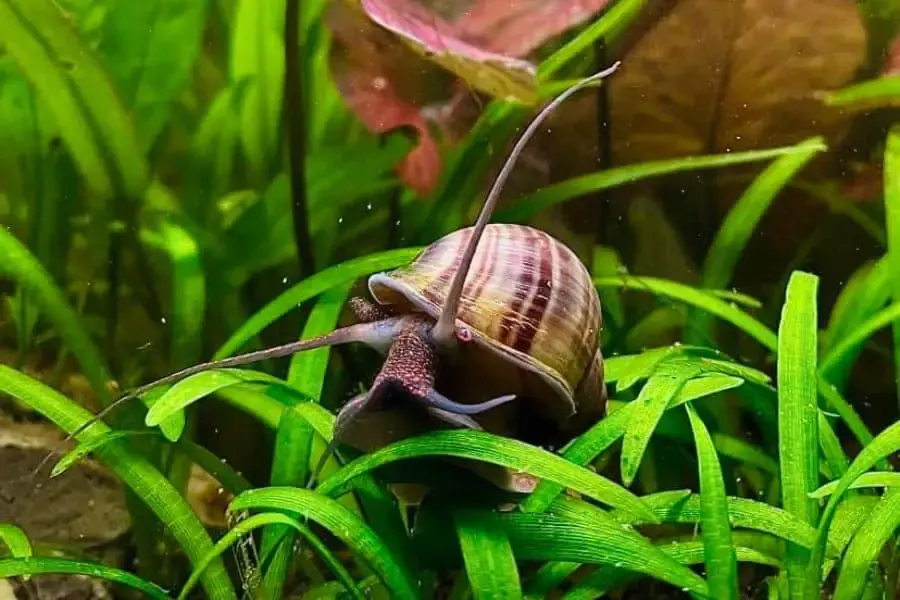
Before you directly jump to setting up a mystery snail aquarium, hold your horses and first learn about the gastropod you bringing home.
Adult Size
Typically, mystery snails can grow up to 1.5 – 2 inches, with females being slightly larger than males. These golf ball-sized snails are among the largest freshwater species of snails.
Behavior
Mystery snails are peaceful invertebrates that get along with shy fish and species of their kind. Although slow-moving, these snails are quite active and spend most of their time munching at the bottom of the tank on algae, dead plant matter, or food leftovers.
Beyond having an aesthetic appeal, mystery snails are known for their unique behavior such as protruding their long snorkel/siphon (for breathing under the water) or climbing up the tank’s wall and then releasing the grip and gliding back down to the bottom.
Appearance & Colors
Popular for their unique appearances, mystery snails come with distinctive shell colors. Some of the common colors include golden yellow, blue, magenta, purple, ivory, chestnut brown, jade green, and black. Patterns or stripes on the shell can also differ in color.
Care Requirements
Mystery snails are relatively low maintenance and easy to care for invertebrates. They can adapt to a variety of water parameters and have minimal feeding requirements.
Lifespan
On average, mystery snails live up to 1-2 years. With proper care, nutrition, and some genetic luck, you can expect a bit longer lifespan – somewhere around 3 years or so.
What Makes Mystery Snails a Popular Choice?
- Apart from showcasing captivating colors and patterns, mystery snails are voracious algae eaters that contribute to the cleanliness of the tank by consuming the unsightly algae growth.
- Additionally, their scavenging ability helps control the accumulation of detritus and uneaten food which keeps the water from degrading, thus promoting a healthier and more stable aquatic environment.
- Mystery snails don’t eat live plants except the decaying or melted plant matter, which makes these freshwater gastropods the safest bet for planted aquariums.
- The best part? It’s easier to control Mystery snail’s breeding as they cannot reproduce asexually or change their sex, unlike many other species of aquatic snails.
Setting Up an Ideal Habitat for Mystery Snails
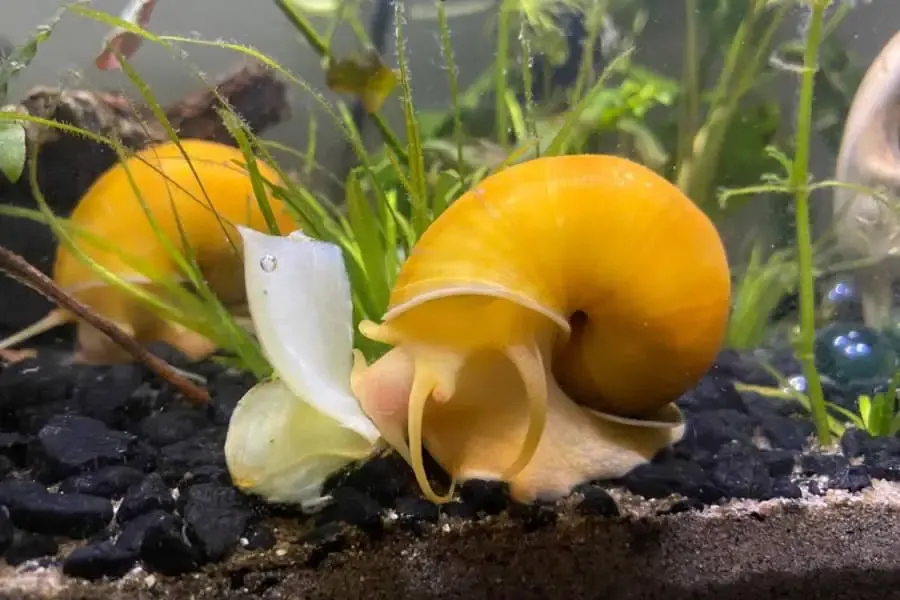
When setting up an aquarium for mystery snails, there are a few factors you need to consider to ensure their well-being and promote a healthy environment.
Selecting an Adequate-size Tank
Keeping the size of mystery snails in mind, you need a minimum of a 5-gallon aquarium to house one of them. If you are going to keep two snails, a 10-gallon or larger tank is required.
Mystery snails poop a lot which can quickly pollute the water, consequently increasing the number of required water changes, especially if you have a smaller tank. Therefore, it is best to have a bigger tank, as it keeps the water parameters stable for longer and less prone to biological fluctuations.
It’s important to note that an aquarium with mystery snails must be secured with a tighter lid to keep these gentle crawlers from escaping.
Suitable Substrate Options
Mystery snails can be kept in both gravel and sand substrates. Whatever you choose as per your convenience, it doesn’t make much difference to the snails.
However, after lurking around the online community forums we have found that most hobbyists prefer keeping their freshwater snails in sand substrates. Blasting Sand and Pool Filter Sand are some of the recommended choices you can look into. Both are cheaper than aquarium sand.
If you are going to keep your mystery snails in pebble or gravel substrate, avoid using stones with sharp edges. Ideally, go for small, rounded pebbles that offers smooth surfaces.
For the snail keepers planning to set up a planted aquarium, you can get Eco-Complete or Seachem Flourite for best results.
Ideal Water Parameters
- The recommended temperature for mystery snails is 70–78°F (21–26°C). Maintaining the tank’s temperature in the upper 70’s is said to be most optimal.
- The pH levels for snails should be kept between 7.2 to 7.5. It’s important to keep the value stable with no fluctuations. Keep in mind, if the pH goes too low (acidic), it will lead to shell deterioration.
NOTE: Adding crushed coral or unflavored cuttlebone to the tank is among the safest and most natural ways to bring your pH up. Under no circumstances, chemicals should be used to alter pH.
- Along with pH, water hardness is another important factor to consider for healthy shell growth. The recommended General hardness (GH) and Carbonate Hardness (KH) are 150 to 180ppm.
Decor Items and Plants
For decoration, you can add driftwood, rocks, and live plants to your snail aquarium. A densely vegetated tank replicates the natural habitat of mystery snails and helps them feel at home.
Mystery snails are safe for planted aquariums (unlike apple snails) as they only eat dead or decaying leaves. However, they may accidentally uproot new plants in loose substrate when they crawl past them.
Does driftwood lower the aquarium’s pH? Not all driftwood lowers the pH; it’s the bogwood that does. The tannins released from the wood are the primary contributor that lowers the pH value of the water. Most importantly, it takes a fair amount of driftwood to alter the pH. One or two small pieces will not do much or may lower it marginally.
Filtration and Lighting
Depending on the size of your tank, you will need a suitably sized filtration system to maintain the cleanliness.
If you are using a HOB filter, it’s suggested to install a pre-filter sponge to avoid your snails getting stuck in the slits covering the intake tube. Additionally, the sponge will help more beneficial bacteria to colonize.
NOTE: Overlooking this advice has injured and killed many snails. So, it’s always better to be safe than sorry.
Also, keep in mind that wrapping a sponge around your filter intake may prevent larger particulates to get through, thus keeping them from getting filtered from the water column. The only way to effectively deal with this issue is to manually clean the sponge during the periodic water changes.
When it comes to lighting, mystery snails prefer dim to moderate lighting conditions. Always avoid harsh or direct lighting.
Monitoring and Maintaining Optimal Water Quality
Mystery snails (and other aquatic snails) are sensitive to poor water conditions. As the water quality starts degrading, they are usually the first to be affected by it.
The presence of toxins such as ammonia and nitrite in the water column is a major indicator of poor water quality. Talking about the accepted levels, ammonia, and nitrite should always be at a constant zero. Nitrate can be anywhere up to 20 PPM, less than 10 PPM being ideal.
Mystery snails are big poopers and can produce bioload equivalent to a fish of a similar size. Therefore, it is recommended to have a strong filtration system, especially if you have a smaller tank.
Besides filtration, performing partial water changes is the best way to keep ammonia levels under control. The frequency and amount can be calculated based on your tank size and bioload.
What Fish Can Live With Mystery Snails?
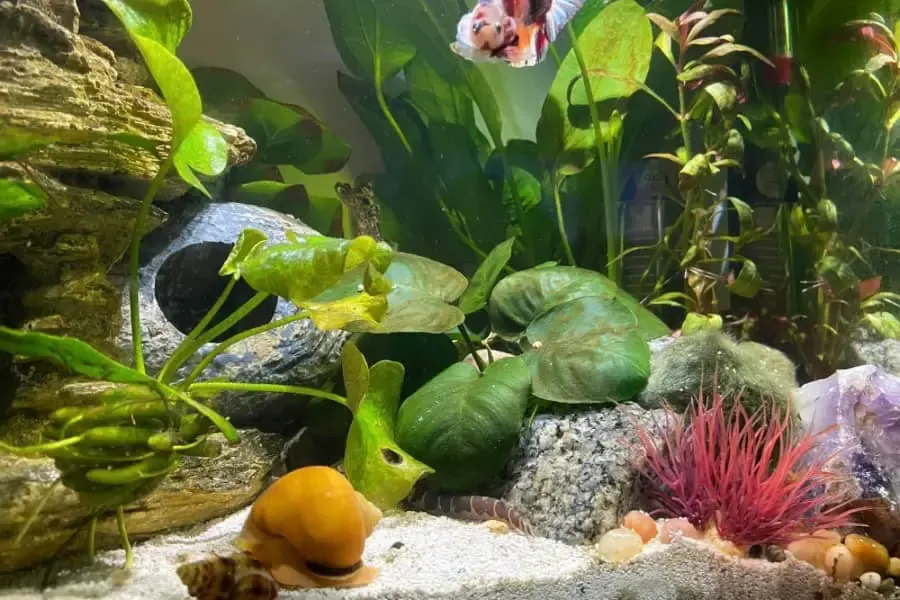
As a peaceful shelled creature, mystery snails can go with anything that won’t hurt them. Small, non-aggressive fish that generally feed top-water and mid-water is a great choice. Avoid any fish that are known for nipping as there is a chance they might go after your snailies antennas.
Following the given rules will significantly reduce the likelihood of your mystery snails becoming a snack.
Also, keep in mind that, the fish you choose to keep with mystery snails should be compatible with living in higher pH and harder water.
If you are feeling clueless, here are a few compatible options you can look into and draw some inspiration for your tank stockings:
- You can keep your Mysteries with Neo Shrimp, Ember Tetras, Cory Cats, Harlequin Rasboras, Kubotai Rasboras, Neons, Corydoras, Kuhli Loaches, and Daisy’s Rice Fish.
- If you want to have more snails, check out Japanese Trapdoor snails, White Wizard Snails, Rabbit Snails, and Nerite snails.
- Betta fish is also a good option. But a bit of a problem might occur with them, especially male Bettas, as they are more aggressive and territorial. So, it’s best to carefully select peaceful and calmer bettas to share the tank with your snails.
NOTE: No matter how gentle or shy a fish is, they might try to bite the snail feelers due to curiosity. So, to be wise is to have an alternate tank ready before your stocking experimentation takes place. At any moment, if see your peaceful critter getting bullied or attacked by the fish, you can instantly shift the problem-causing tankmates or the victim to the new tank.
What to Feed Mystery Snail?
When looking for food options for snails, it’s not unusual to come across misleading and rather distressing advice like: “Snails don’t even require to be fed. They will clean the tank and get their food from there.”
It’s true, that most of the time aquarists buy mystery snails to control algae growth and for scavenging purposes, but you still need food for them to eat. Never listen to any suggestions that state otherwise. Remember, not many things kill a snail, but starvation certainly does.
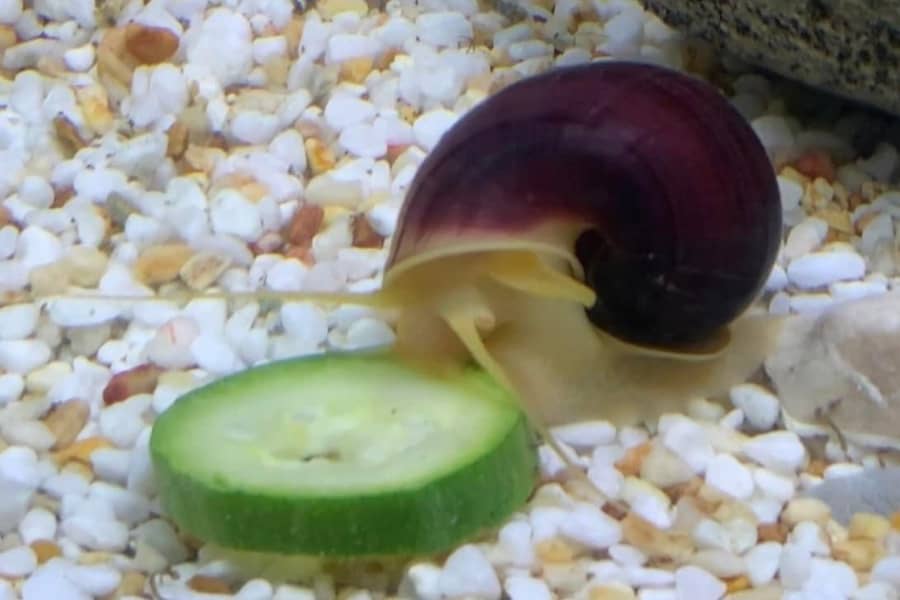
Mystery Snail Eats Cucumber
So, getting the common myth out of the way, here are some of the best food choices for your mystery snails.
- To ensure they get plenty of minerals in their diet for strong and healthy shell growth, feed them calcium-rich vegetables like blanched spinach, lettuce, kale, or zucchini.
- Commercial fish food including HIKARI Algae Wafers, Aqueon Sinking Pellets, and Tetra Min Tropical Flakes are some of the most recommended choices of mystery snail owners.
- You can make gel-based snail food, commonly known as “snello.” There are tons of recipes on YouTube.
NOTE: Calcium is the most important nutrient for snails’ dietary requirements.
Be Ware of Copper – The Snail Killer
Copper or copper sulfate is a lethal heavy metal responsible for killing invertebrates, including snails.
Ideally, one should avoid feeding any food to the mystery snails that contain copper. But, nowadays, all commercial fish food uses copper sulfate as a preservative to prevent fungus growth. So only if the copper is listed as the last ingredient you can feed it to your snails.
Nevertheless, you don’t want the leftover food to dissolve in the water and potentially leech the toxic copper. So make sure all the food is eaten within 2 hours, if not, you vacuum it out.
Helping Sick Mystery Snails: Guide to Common Health Problems and Treatments
There are not many health conditions mystery snails are affefted by, but a very few, that if not treated early may worsen the issue or may eventually kill them.
Shell Deterioration
Calcium plays a vital role in promoting the shell growth. When snails don’t get adequate calcium, the deficiency usually leads to weaker, thinner shells, causing discoloration and cracks or holes in the structure.
Apart from feeding calcium-rich veggies, you can dose the water column with calcium supplements to restore your snail’s shell health.
Cuttlebone is widely recommended for this purpose. However, it’s not effective for tanks bigger than 5 gallons. You’ll need to buy calcium powder (no tabs) that has no other ingredients than calcium. It’s readily available on PetCo and PetSmart, or you can order it from Amazon.
Add 1 tablespoon per 20 gallons, or you can use 2 tablespoons if this is your first time dosing calcium. And then 1 tablespoon every time you do the weekly water change.
Mind you, this will make your tank cloudy until all the calcium settles. If you notice any flurries or the calcium power bunched up and collected at a spot, stir the water gently to redistribute and dissolve the residue.
For the calcium to dissolve fully into your tank, it may take up to a few hours to days depending on your filter’s capacity.
Mystery Snail Swollen Foot: Causes & Remedy
If your snail’s foot looks swollen, it can be due to poor water quality or a reaction to a chemical recently added.
To know the actual cause test the water parameters. Don’t use test strips as they aren’t accurate. Instead, go for API freshwatwer aquairum kit. If required (based on the test results) do water changes.
To help the swelling, put the snail into a dish and pour water from the tank that’s enough to cover its foot. Provide food to the little shelled creature to eat and wait for 10-15 minutes before putting it back into the tank.
Repeat this process (expect giving food everytime) few times a day until the swelling goes down.
Mystery Snail Operculum Issues
Receding operculum: It’s an indicator of old age or sickness. You need to check the water parameters and perform multiple small water changes depending on the test results. Also, make sure you are feeding the snail adequate amount of food.
Damaged or broken operculum: As long as the operculum is attached to the snail’s foot despite the damage, worry not as it will regenerate. But it’s going to take long time. Meanwhile, feed your snail high-quality shrimp pellets (as they contain protein) to promote the operculum healing and growth.
Operculum fell off: If the operculum has completely fallen apart, your snail may or may not survice. To take your best bet, isolate your snail if you have fish or other tankmates that might try nipping through the open spots, feed high protein food, and most importantly, make sure your water parameters are on point.
Mystery Snail Mantle Collapse
Mantle collapse refers to the complete disconnection of body from the shell where the snail can’t retract. It can happen due to variety of reason, with nitrite poisoning being more prevalent.
In this case there is not much you can do but euthanize the tiny creature to put an end to its suffering. There are different humane ways to do it, depending on what you are comfortable with.
Why Is My Mystery Snail Floating?
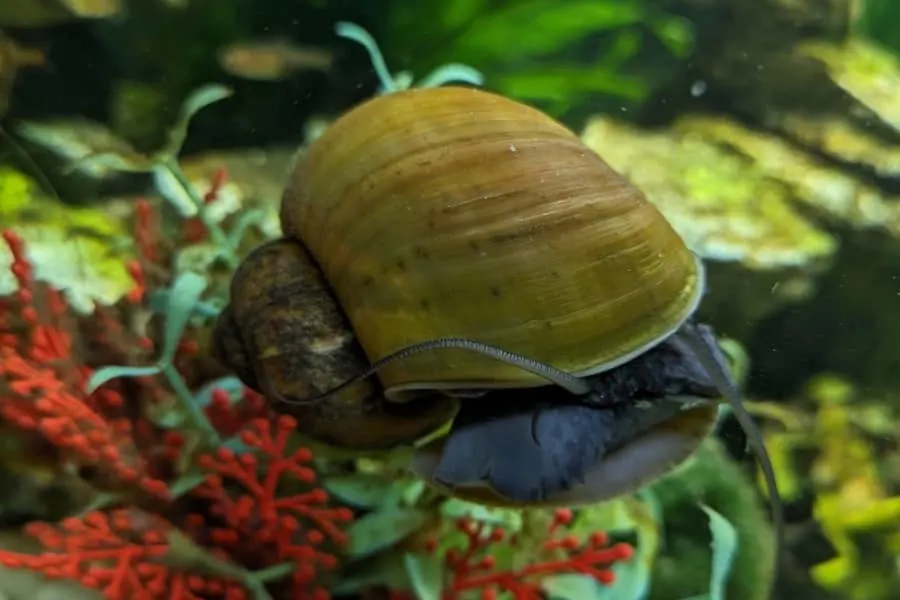
It’s normal for mystery snails to float for a while due to the air trapped in their shell. However, if the floating behavior continues for a day or more, it indicates acclimatization or water quality issues. Freshwater snails, including mysteries are sensitive to sudden pH changes.
NOTE: Before you take any measure, make sure the snail is alive. Otherwise all efforts goes into vain if the snail is already passed away. If you don’t know how to confirm it, check out the following section.
To see what’s going on with your water parameters, you can use API Freshwater Test Kit. Safe ranges for the ammonia, nitrite and nitrate are 0,0,20 ppm respectively. For pH, it should be within 7.2 – 8, with 7.6 being ideal.
As the test results comes, and if you find anything off, take the appropriate measure to fix the issue. If the water parameters appear to be dangerously far from the safe ranges, it’s wise to take the snail out of the tank and temporarily rehome the gastropod until you make its habitat liveable again.
How to Tell If Mystery Snail Is Dead (or Sleeping)?
Mystery snails have no definite sleep cycle. They can sleep for multiple hours and sometimes even for days as long as 3.
If yours has been in the same position or spot for long enough that you’ve started suspecting whether it’s dead, dying or just taking a restful sleep. Here is what you should to:
- Take the snail out of the tank and smell the shell opening. A dead snail stinks horrible as it starts to rot quickly.
- Another way is to gently poke on the snail’s trap door and if you feel any resistance, it means the snail is alive and probably sleeping. A dead snail can’t resist and you should be able to open its door.
- Snail hanging or sticking to a surface is an indication of being alive.
- Mystery snails can also retract to their shell and remain closed when water parameters aren’t suitable.
Conclusion
We hope with the information shared above, now you posses a crystal clear understanding of mystery snails care. And better off, you are convinced that it is easy to keep and raise the bold and beautiful mystery snails.
